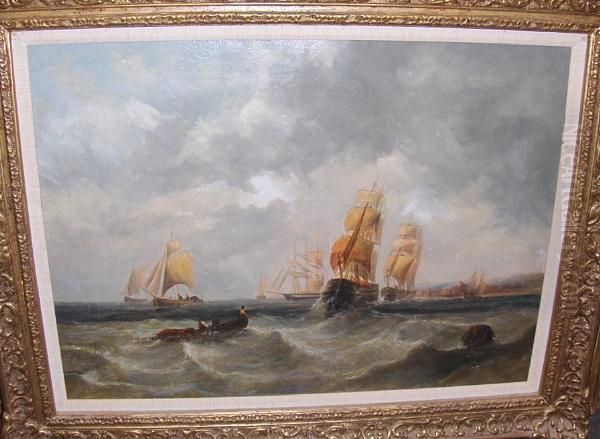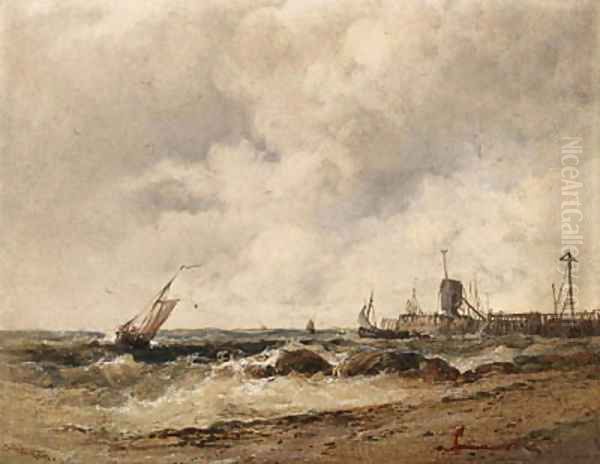
James Webb (1825-1895) stands as a significant figure in the landscape of 19th-century British art. Born and based in Chelsea, London, throughout his life, Webb dedicated his artistic career primarily to capturing the dynamic beauty of seascapes and the diverse character of landscapes. Flourishing during the Victorian era, a period marked by immense industrial change, colonial expansion, and evolving artistic tastes, Webb carved out a niche for himself, becoming particularly renowned for his evocative marine paintings. His work, while rooted in observation, often carried the dramatic flair and atmospheric sensitivity inherited from the giants of British Romanticism, positioning him as a notable practitioner within the British school of painting.
Webb's artistic journey unfolded against a backdrop rich with artistic precedent and contemporary innovation. He operated in the long shadow cast by the revolutionary landscape and marine painters J.M.W. Turner and John Constable, whose approaches to light, atmosphere, and naturalism had fundamentally reshaped British art earlier in the century. Webb absorbed these influences, blending Turner's penchant for atmospheric effects and dramatic compositions with Constable's dedication to the tangible reality of the natural world. His lifetime also overlapped with the rise of the Pre-Raphaelite Brotherhood, whose members like John Everett Millais and Dante Gabriel Rossetti championed meticulous detail and moralistic themes, offering a stark contrast to the broader, more atmospheric handling often seen in Webb's generation of landscape artists.
Artistic Style and Influences
The core of James Webb's artistic identity lies in his distinctive style, often described as "robust" and "naturalistic," yet consistently infused with a sensitivity to mood and atmosphere. His paintings characteristically feature a solid grounding in observation, depicting recognizable locations and maritime activities with a convincing sense of place. However, Webb was not merely a topographical recorder. He imbued his scenes with subjective feeling, often employing a palette noted for its "soft tones" while simultaneously being capable of capturing the dramatic interplay of light and shadow, particularly in his coastal and marine subjects. This blend suggests a careful balancing act between objective representation and Romantic expression.

The influence of J.M.W. Turner is palpable in Webb's treatment of light and atmosphere. Like Turner, Webb was fascinated by the effects of weather on the sea and sky – the turbulence of storms, the glow of sunsets, the haze of morning mist. He often used light not just to illuminate but to dramatize his scenes, creating focal points and enhancing the emotional impact. From John Constable, Webb seems to have inherited a commitment to the textures and specificities of the British landscape, grounding his more dramatic scenes with believable details of terrain, foliage, and architecture. Webb synthesized these influences into a personal style that resonated with Victorian audiences, who appreciated both the recognisable subject matter and the evocative, often picturesque, presentation.
A Focus on Marine Painting
James Webb excelled in the genre of marine painting, a field with a long and distinguished history in Britain, tied intrinsically to the nation's identity as a maritime power. The Victorian era saw continued fascination with the sea – as a source of national wealth and power through trade and the navy, a place of dramatic shipwrecks and heroic rescues, and increasingly, a destination for leisure and contemplation. Webb tapped into this cultural interest, producing numerous works that explored the multifaceted relationship between humanity and the sea. His canvases often feature bustling harbours, fishing boats returning with their catch, coastal shipping navigating choppy waters, or dramatic views of cliffs and shorelines under varying weather conditions.
His approach to marine subjects often involved a degree of romanticisation, emphasizing the picturesque or dramatic aspects of coastal life and scenery. He was adept at capturing the movement of water, the textures of sails and rigging, and the solidity of coastal fortifications or harbour walls. In this focus, he followed in the wake of earlier marine specialists like Clarkson Stanfield, who was renowned for his large-scale, often theatrical, sea pieces and coastal views. Webb’s work, while perhaps less overtly theatrical than Stanfield's at times, shared a similar commitment to conveying the power and majesty of the ocean, alongside the human activities that unfolded upon and beside it. Edward William Cooke was another prominent contemporary marine painter whose detailed and scientifically informed depictions of shipping and coastal geology provide an interesting comparison to Webb's broader, more atmospheric approach.
Landscapes of Britain and Beyond

While renowned for his seascapes, James Webb was also a prolific painter of landscapes. His subjects spanned the British Isles, including scenes in England, Wales, and Scotland. He possessed a keen eye for the particular character of different regions, from the rugged coastlines of the north and west to the gentler scenery of the south. His travels also took him further afield, reflecting a common practice among British artists of the period seeking new subjects and inspirations. Webb painted extensively on the Continent, capturing views in the Netherlands, along the Rhine River in Germany, and in France. His depictions of Mont Saint-Michel, for instance, highlight his interest in dramatic architectural subjects situated within striking natural landscapes.
These continental excursions broadened his repertoire and exposed him to different light conditions and landscape types. His Dutch scenes, likely depicting ports and estuaries, connect him to the long tradition of Dutch Golden Age marine painting, perhaps echoing the work of artists like Willem van de Velde the Younger or Ludolf Bakhuizen in their attention to shipping and atmospheric coastal light. His views along the Rhine would have engaged with a landscape already heavily romanticized by artists and writers, including Turner himself. Webb's landscape work, like his marine painting, often balanced topographical accuracy with an enhanced sense of atmosphere and picturesque composition, appealing to the Victorian taste for both familiar and exotic scenery. His British landscapes can be viewed alongside the work of popular contemporaries like Benjamin Williams Leader, known for his detailed and often serene views of the English and Welsh countryside, though Webb often brought a more dynamic, coastal energy even to his inland scenes.
Light, Atmosphere, and Technical Skill
A defining characteristic of James Webb's painting is his masterful handling of light and atmosphere. Whether depicting the clear light of a summer afternoon, the diffused glow of a hazy morning, or the dramatic contrasts of a storm-laden sky, Webb used light to unify his compositions and evoke specific moods. His reported use of "soft tones" suggests a subtle colour harmony in many works, perhaps avoiding the harsher chromatic contrasts favoured by some contemporaries. This sensitivity to atmospheric conditions allowed him to convey the feeling of air, space, and weather, crucial elements in both landscape and marine painting.
Furthermore, Webb was noted for his technical proficiency. His "detailed brushwork" allowed him to render the specifics of ships, architecture, and figures with clarity, adding a layer of realism and interest to his scenes. This ability to handle detail within a broader atmospheric context demonstrates a versatile technique. Unlike the sometimes microscopically detailed approach of Pre-Raphaelite landscape painters like John Brett in his coastal scenes, Webb generally maintained a balance, ensuring that details served the overall composition and mood rather than dominating it. His skill extended to depicting the human element within his landscapes and seascapes, populating his scenes with figures that contribute to the narrative or scale without becoming the primary focus. This comprehensive skillset underpinned his ability to produce convincing and engaging views across his chosen genres.
Notable Works and Recurring Themes
Among James Webb's known works, paintings such as 'Mont Orgueil Castle, Jersey' and views of 'St Aubin's Bay' exemplify his interest in dramatic coastal locations, often featuring historical architecture. Castles perched on cliffs or headlands were a popular subject in the Romantic and Victorian periods, evoking history, resilience, and the picturesque decay or enduring strength of man-made structures against the power of nature. Webb's depictions likely emphasized the atmospheric setting, perhaps showing the castle under different light or weather conditions, integrating it fully into the surrounding land and sea.
His works frequently explored themes central to marine art: the power and unpredictability of nature, particularly the sea; the resilience and industry of coastal communities; the beauty and variety of shipping; and the historical resonance of coastal landmarks. He often depicted scenes of everyday maritime life – fishing fleets, harbour activity, coastal trade – grounding his work in the realities of the Victorian era's relationship with the sea. However, he elevated these scenes through his attention to composition, light, and atmosphere, often choosing moments of heightened visual interest, such as sunrise, sunset, or approaching storms. His travels also introduced themes related to continental European landscapes and waterways, capturing the distinctive character of Dutch ports or the romantic scenery of the Rhine valley, complete with its castles and vineyards.
Exhibition Career and Recognition
James Webb was actively involved in the London art world, regularly exhibiting his works at the major venues of the day. He frequently showed paintings at the prestigious Royal Academy of Arts, the primary showcase for contemporary British art, where inclusion signified a level of professional achievement and provided crucial exposure to patrons and critics. He also exhibited at the British Institute and likely at the Society of British Artists on Suffolk Street, institutions that offered alternative but important platforms for artists to display and sell their work. This consistent presence at major exhibitions indicates that Webb achieved considerable recognition during his lifetime.
His paintings, with their appealing blend of naturalism, atmospheric effect, and often dramatic or picturesque subject matter, found favour with the Victorian public and collectors. While perhaps not reaching the towering fame of Turner or the revolutionary impact of the Pre-Raphaelites, Webb established himself as a respected and successful painter within his chosen field. His ability to capture the specific character of diverse locations, from the coasts of Britain to the waterways of Europe, combined with his technical skill and sensitivity to mood, ensured a steady demand for his work. The inclusion of his paintings in national collections like the Victoria and Albert Museum and the Tate Gallery further attests to his standing in British art history.
Webb in Context: Comparisons and Contemporaries
Placing James Webb within the broader context of Victorian art helps to appreciate his specific contributions. While influenced by Turner and Constable, his work differs significantly from the meticulous detail and vibrant colour of the Pre-Raphaelites like William Holman Hunt or Millais. His atmospheric concerns might find echoes in the moonlit urban and dockland scenes of Atkinson Grimshaw, although Webb's focus was generally broader daylight landscapes and seascapes. Compared to the often tranquil and highly finished rural scenes of popular landscape painters like Myles Birket Foster, Webb's work frequently possessed a greater sense of dynamism, particularly in his marine subjects.
His engagement with continental subjects invites comparison with French artists working along the Channel coast, such as Eugène Boudin, who became famous for his depictions of fashionable beach life and atmospheric skies, though Boudin's style was generally looser and more proto-Impressionistic. Webb's more robust, narrative style remained firmly rooted in British traditions. He can be seen as part of a strong lineage of British marine painters that includes figures like Stanfield and Cooke, maintaining the popularity of the genre throughout the Victorian period. Even generalist painters known for narrative scenes, like William Powell Frith, occasionally depicted coastal settings, highlighting the broad appeal of such subjects during the era. Webb's specific blend of influences and his focus on atmospheric marine and landscape views secured his distinct place within this crowded and vibrant artistic scene.
Legacy and Conclusion
James Webb's career spanned a significant portion of the Victorian era, and he remained a consistent producer of landscape and marine paintings throughout his life. He successfully navigated the changing tastes of the time, adapting the legacy of Romanticism to suit Victorian sensibilities. His work provided audiences with evocative glimpses of their own coastlines and popular travel destinations abroad, rendered with technical skill and atmospheric sensitivity. He stands as a key figure in the continuation of the British marine painting tradition after Turner, alongside contemporaries like Stanfield and Cooke.
His legacy resides in the substantial body of work he left behind, capturing the diverse landscapes and maritime life of Britain and parts of Europe during a period of significant transformation. While not an avant-garde innovator, Webb was a highly accomplished painter who mastered his chosen genres, creating works that were admired in his own time and continue to be appreciated for their evocative power and historical interest. The presence of his paintings in major public collections, including the Victoria and Albert Museum and the Tate Gallery in London, ensures his continued recognition as an important contributor to the rich tapestry of 19th-century British art, a skilled interpreter of the enduring allure of the sea and shore.